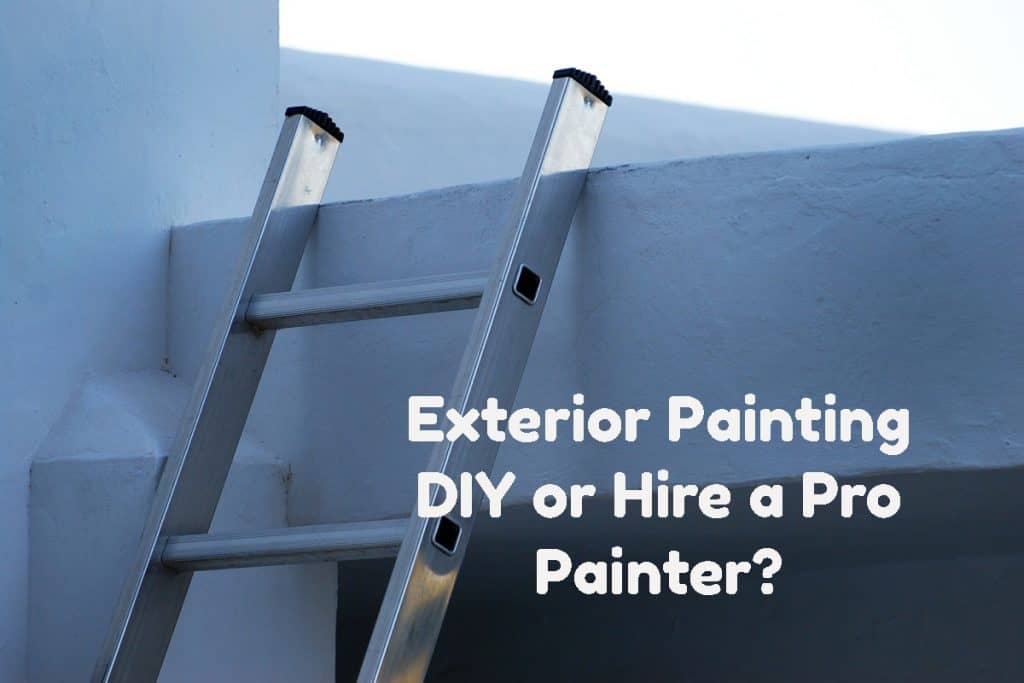Exterior Painting: DIY or Hire A Pro Painter?

Exterior House Painting:
Do it Yourself or Hire A Pro Painter?
Painting the exterior of a house can look intimidating but if you follow the basic guidelines in this article you should be good-to-go!
A couple of things to consider first: Are you afraid of heights and are you in good physical condition? It can be challenging work which requires both endurance and strength.
- Heights: A single bungalow type home is approximately 10 feet in height. A two story house can be 20-25 feet. If you have a walk-out basement is may be closer to 30’ in the back.
- Physical Condition: Make sure you are strong enough to carry and position an extension ladder. The aluminum ladders are preferable because they are lighter in weight. Scraping and sanding a surface while working on a ladder will take some coordination and strength in the arms, shoulders, legs and abs.
Do You have the Tools?
The job will go faster and you’ll get better results if you own the right tools for the job. Some can be rented like ladders,scaffolding, pressure washer,and a paint sprayer.
The Bare Minimum Tools Required for Exterior Painting:
- Step ladder & extension ladder
- Electric palm sander
- 100' extension cord
- Hand scrapers
- Putty knives
- Paint brushes & paint rollers
- Extension handles for paint roller
- Caulking gun
- Drop cloths
- Safety harness for roof work
- Safety glasses & hearing protection
Safety First!
- The most important thing is to take things slowly and be safe. Make sure the bottom of the ladder is secured and placed on level,solid ground. It’s best to use ladder levelers, or 2”x 10” lumber, or plywood, or scaffold planks on uneven surfaces.
- Make sure the extension ladder is one foot away from the side of the house for every four feet that the ladder rises in height. A 20’ ladder, for example, should be 5’ away from the wall.
- Never lean a ladder against a window or glass.
- Use ladder standoffs if you require more clearance away from the wall at the top.
- Wrap the top of the ladder with soft cloths or buy rubber ladder caps to protect surfaces from marring or scratching.
- Always wear hearing and eye protection when you are doing any spray painting, or scraping & sanding.
- Wear fall protection if you are working on a roof.
Prep Work is Very Important
Your home is a big investment and you want to protect the exterior surfaces from the rain,sleet,snow, and the UV rays of the sun.. Do a great job preparing the surfaces for paint. Take your time and don’t rush it. Pressure wash the house first and then start the scraping,filling,sanding, and caulking. When in doubt,use a primer to seal the surfaces. It’s also important to prime any spackling or wood filler before painting.
Quality Exterior Paint & Stains
Purchase the best paint you can afford. This is not the time to look for a bargain based paint. Remember that the paint has to protect against the severe weather conditions in Calgary. I’d recommend applying two finish coats on each surface. Premium paints will also cover better than inexpensive brands and quite often are more fade resistant. The old adage,”you get what you pay for” stands true when it comes to house paint.
Each Surface May Require a Different Coating
It’s important to learn about specialty coatings and what paint or stain a manufacturer may recommend for a particular substrate.Paints are different than stains for example. Hardy Board siding may require a different paint than vinyl or aluminum siding. Decks and fences are most often coated with stains. You'll need to decide if you want an opaque or a translucent finish. Windows, doors and trim are usually painted in a higher sheen than the body of the house. The physical condition of the substrate can also factor into your decision. A flat paint,for instance, will hide imperfections better than a semi-gloss. Talk to a paint store rep or do some research online to help in your decision making process.
Weather Conditions and the Moisture Content of Wood
Obviously keep an eye on the weather forecast before you decide to paint. Most acrylic paints dry relatively quickly so you may be safe if it rains 2 hours after it has dried. Some paints are better than others at holding up to a sudden rain shower than others. This also relates to colder weather conditions. I know of a few brands that can be applied in weather as low as 2 degrees celsius.
Try to follow the shaded areas of the house throughout the day. The best practice is to not apply paint in direct sunlight on very hot days. The finish can be affected because it dries too quickly. Start in the early morning when it’s cool. Add a paint conditioner to extend the dry time of the coating if the weather is hot. Acrylic paint conditioners will also make it easier to brush and roll under any conditions.
Finally, make sure the wood is dry enough to accept paint or stain. Let it dry out for 2-3 days after washing, or a rain shower. This is especially important for deck floors. They sell moisture meters that will determine how dry the wood is if you are in doubt. They are inexpensive relative to the cost of having to repaint the surface if it fails.
